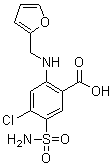Home > Offer to Sell > Intermediates > Pharmaceutical intermediates > Furosemide CAS 54-31-9 (jerryzhang001@chembj.com)
Furosemide CAS 54-31-9 (jerryzhang001@chembj.com)
Inquiry
| Post Date: | Mar 24,2017 |
| Expiry Date: | Mar 24,2018 |
| Detailed Description: |
Cas No. :54-31-9
Furosemide CAS 54-31-9
Product Name: Furosemide; Synonyms: LABOTEST-BB LT00244801;FUROSEMID;FUROSEMIDE;FRUSEMIDE;2-furfurylamino-4-chloro-5-sulfamoylbenzoic acid;4-CHLORO-N-FURFURYL-5-SULFAMOYLANTHRANILIC ACID;5-(AMINOSULPHONYL)-4-CHLORO-2-[(2-FURANYLMETHYL)AMINO]BENZOIC ACID;5-[AMINOSULFONYL]-4-CHLORO-2-[(2-FURANYLMETHYL)AMINO]BENZOIC ACID; CAS: 54-31-9; MF: C12H11ClN2O5S; MW: 330.74; EINECS: 200-203-6; Product Categories: Organics;Intermediates & Fine Chemicals;Pharmaceuticals;API's;Ion transporter and other ion channel;GABA;Aromatics;Heterocycles;Sulfur & Selenium Compounds;API;LASIX;Other APIs; Melting point: 220 °C (dec.)(lit.); density: 1.606; Fp: 11 °C; storage temp.: 2-8°C; Description: Furosemide, sold under the brand name Lasix among others, is a medication used to treat fluid build-up due to heart failure, liver scarring, or kidney disease. It may also be used for the treatment of high blood pressure. The amount of medication required depends on the person in question. It can be taken intravenously or by mouth. When taken by mouth it typically begins working within an hour while intravenously it typically begins working within five minutes. Furosemide, is a class of efficient sulfonamide diuretics acting on the medullary loop of the ascending branch of the medulla,it has a strong and short-term diuretic effect,which can increase the excretion of water, sodium, chloride, potassium, calcium, magnesium, phosphate and so on. It Mainly inhibits Na + and Cl- reabsorption in medullary and cortex of the medullary loop ascending branch crude segment , it can promote the excretion of sodium, chloride and potassium and affect the formation of renal medullary high osmotic pressure,it can interfer the process of concentration and dilution of urine, and it can increase urine output. This product can inhibit the activity of prostaglandin decomposition enzyme ,make the content of prostaglandin E2 increase,it has effect on expansion of blood vessels, it also plays a role in the proximal tubule, glomerular filtration,it can increase renal blood flow,and adjust renal blood flow distribution,and reduce blood flow so that the cortex surface blood flow increases,it promotes diuresis, its effect is fast and strong, it is used for other diuretics invalid cases. Clinical Application: Clinically it is used for the treatment of cardiac edema, renal edema, cirrhosis ascitic fluid, peripheral edema caused by dysfunction or vascular disorders , and it may contribute to an upper urinary tract stones excretion. Administration intravenously can treat brain edema, it also can accelerate the excretion of toxic substances in cerebral edema in poisoning . Note that when the diuretic furosemide is used, since the excretion of urine Cl-, Na +, K +, H + is increasing, while the excretion of HCO3- is not increasing, long-term repeated drug use or large quantities of drugs can cause low salt syndrome, low chlorine and low potassium alkalosis. It can inhibit the release of the neurotransmitter acetylcholine and substance P, which may be related to inhibiting chloride ions into the cell membranes of respiratory tract. Clinically,it is used in exercise-induced asthma, immediate and delayed type antigen-induced asthma. Usage: The diuretic effect of this product is a strong and short,it is a potent diuretic for the treatment of edema caused by heart, liver, kidney and other diseases, in particular, the base cases which other diuretics are invalid to;it can be used to treat acute pulmonary edema, brain edema , acute renal failure and high blood pressure and other diseases; in combination with fluid infusion, the product can promote poison excretion. Furosemide is primarily used for the treatment of hypertension and edema. It is the first-line agent in most people with edema caused by congestive heart failure. It is also used for hepatic cirrhosis, renal impairment, nephrotic syndrome, in adjunct therapy for cerebral or pulmonary edema where rapid diuresis is required (IV injection), and in the management of severe hypercalcemia in combination with adequate rehydration. Kidney Disease: In chronic kidney diseases with hypoalbuminemia, it is used along with albumin to increase diuresis. It is also used along with albumin innephrotic syndrome to reduce edema. |
| CAS Registry Number: | 54-31-9 |
| Synonyms: | ;5-(aminosulfonyl)-4-chloro-2-((2-furanylmethyl)amino)benzoic acid; 4-chloro-n-furfuryl-5-sulfamoylanthranilic acid; 2-furfurylamino-4-chloro-5-sulfamoylbenzoic acid;Frusemide; |
| Molecular Formula: | C12H11ClN2O5S |
| Molecular Weight: | 330.74 |
| Molecular Structure: | 
|
| Hazard Symbols: |  T:Toxic; T:Toxic; |
| Risk Codes: | R61:; |
| Safety Description: | S22:; S36/37/39:; S53:; S45:; |
| Company: | Nanjing Bangnuo Biotechnology Co., Ltd. [ China ] |
| Contact: | Jerry Zhang |
| Tel: | 86-25-52198306 |
| Fax: | 86-25-52198306 |
| Email: | jerryzhang001@chembj.com |
-
Disclaimer statement:The information and data included above have been realized by the enterprises and compiled by the staff, and are subject to change without notice to you. The Chemnet makes no warranties or representations whatsoever regarding the facticity, accuracy and validity of such information and data. In order to ensure your interest, we suggest you chose the products posted by our gold suppliers or VIP members.


